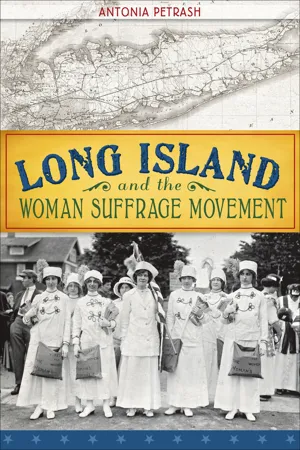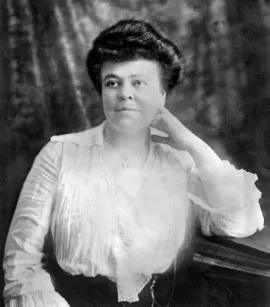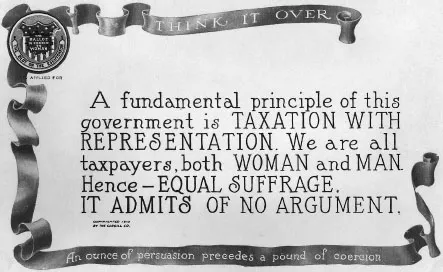![]()
Chapter 1
ALVA VANDERBILT BELMONT
1853–1933
Demand your suffrage…The world is calling for the great half force, so long and so wrongly ignored, and in this union of man and woman lies a future of a wondrous whole. Just trust in God. She will help you.
–Alva Vanderbilt Belmont
The blue suffrage flag, with its four white stars, fluttered gaily in the breeze that warm August afternoon in 1909 in Newport, Rhode Island. There was excitement in the air as six hundred people, mostly women, descended on Marble House, the opulent stone palace built by Alva Vanderbilt Belmont and her first husband, William K. Vanderbilt. Some purchased one-dollar tickets that allowed them to hear such illustrious speakers as Anna Howard Shaw and Julia Ward Howe, while others held tight to their five-dollar tickets that admitted them on a house tour, up the majestic yellow marble staircase and through the rooms of the impressive Beaux Arts mansion.
But not everyone felt that the suffrage rally held in the summer colony of Newport was a good idea. There were murmurings among the other residents that Alva’s suffrage meetings had brought too much undesired publicity for Newport. As photographers roamed through the crowds, snapping photos, some of Alva’s disapproving neighbors (who nonetheless couldn’t resist attending) turned their backs to avoid being photographed—to avoid such obvious evidence of their hypocrisy.13
Alva cared little what these women thought. She had opened her home and her heart to a cause in which she fervently believed, spending thousands of dollars of her own money. Benefits realized from her open house that day for the woman suffrage movement would be impressive, both in funds and publicity, and even some staunch Newport residents were convinced by the speeches to embrace the suffrage cause. But Alva did want to keep the goodwill of the summer community, so she promised her Newport friends that she would invite them to a luncheon where no mention of suffrage would be spoken.
Alva Vanderbilt Belmont. Courtesy of the Library of Congress.
She kept her word. But as the women sat down to the delicious lunch, Alva’s message was still heard loud and clear, for rimming the lovely white porcelain dishes in blue script was the eloquent but silent plea: “Votes for Women.”14 The women got the message, whether they wanted it or not.
Alva Vanderbilt Belmont was unarguably the most outspoken and controversial advocate for woman suffrage that Long Island had ever seen. She was immensely wealthy, and her wealth imbued her with an unmitigated desire to have her own way, no matter the cost. Some liked her. Most respected her. Many loathed and avoided her at all cost. But despite some unpleasant character flaws, Alva Vanderbilt Belmont was fearless and loyal. If she was blunt and insulting, well, that was just too bad. She was not afraid to spend enormous sums of her own money to right what she considered an egregious wrong to all women—denial of the right to vote.
Alva Erskine Smith was born on January 17, 1853, in Mobile, Alabama, seventh of nine children of cotton merchant Murray Forbes Smith and his wife, Phoebe Ann Desha. (Only five children survived.) The family was prosperous though not wealthy. Her father was descended from the Stirling family of Scotland. Her mother was the daughter of Tennessee congressman Robert Desha. A few years before the Civil War, the family moved to New York, where they entered briefly into New York society, and then to Europe, where Murray found work in England and Phoebe took the children to live in France.15
By her own admission, Alva was a difficult child, combative and determined to have her own way from an early age, a “born dictator.” Like many men of the time, her father prized sons, feeling that the family was better represented by them rather than by its daughters. Alva’s deep resentment of her father’s preference for her brothers might account, at least in part, for her lifelong determination to prove herself right and equal at all costs.
Alva blossomed in the three years she spent in France. She studied in a French boarding school and became entranced with all things French. In 1869, when her father decided that the family must return to live in New York, Alva was heartbroken. She loved the French language, culture and art and, at the age of sixteen, was afraid of the challenges she would face reentering New York society.
Acceptance into New York society would prove difficult for the Smiths, having been away for four years. In 1871, Phoebe Smith died, and Alva was distraught, feeling that she had lost the only person who had ever really understood her. Her father’s business dealings went into decline, and after two years of flirting with “genteel poverty,” Alva decided that the only way to rescue her family from penury was to marry and marry well. A childhood friend, Consuelo Yznaga, introduced her to the wealthy William K. Vanderbilt, grandson of Cornelius Vanderbilt, the American industrialist who had made his fortune in shipping and railroads and who was reported to be the wealthiest man in America. In 1875, Alva and William K. Vanderbilt were married. Alva was twenty-two years old.16
With her newly found fortune and her new husband’s approval, Alva began a building program designed to dazzle New York society. She hired architect Richard Morris Hunt to build her a $3 million chateau on Fifth Avenue, a $2 million Newport Rhode Island “cottage,” Marble House, and a one-hundred-room mansion in Oakdale, Long Island, called Idlehour (now home to Dowling College). The couple had three children: Consuela, born in 1877; William Kissam Jr., born in 1878; and Harold Stirling, born in 1884.17
Despite their enormous wealth, Alva never felt completely comfortable with their position in New York society. Certain that having English nobility in the family would solidify that tenuous position, she determined to marry their daughter, Consuela, to a member of the English royalty, despite the fact that the young woman was in love with someone else. In November 1895, she virtually forced Consuela to marry Charles Richard John Spencer-Churchill, the ninth duke of Marlborough, thus condemning her daughter to an unhappy marriage thousands of miles away in England. (In later years, when Consuela was attempting to obtain an annulment, Alva would finally confess that she had forced the girl into the marriage.)
Alva and William K.’s own marriage was not a happy one; they divorced in 1895, a few months before Consuela’s wedding. It was one of the first divorces of their social class. Alva received an enormous settlement—close to $2.3 million dollars, an income of $100,000 per year, the deed to Marble House and sole custody of their three children.18
On January 11, 1896, she married Oliver Hazard Perry Belmont, son of a wealthy banker and grandson of Commodore Matthew Calbraith Perry, who had commanded the naval expedition that opened U.S. diplomatic relations with Japan in 1854. At his father’s death in 1890, Oliver’s inheritance was rumored to be $60 million.19 In 1897, Alva again turned to her architect friend Richard Morris Hunt to build them a mansion in East Meadow, Long Island, which they called Brookholt. But Alva’s newly found marital happiness was not to last; Oliver died suddenly of complications from an appendectomy in 1908, leaving her his entire fortune.
For the first time in her life, Alva was completely alone. Her children were grown and no longer needed her. She was financially one of the richest women in America but felt bereft and depressed. Her daughter’s marriage was already over, as was the marriage of her son Willie K., and she was facing a life of useless loneliness. But fortunately for the then-struggling woman suffrage movement, all that was about to change.
In March 1909, another Long Island socialite, Katherine Duer Mackay—who had been a bridesmaid at Consuela’s wedding—invited Alva to her home in Roslyn to listen to a lecture by Ida Husted Harper, author of the History of Woman Suffrage and The Life and Work of Susan B. Anthony. Harper expressed concern that the movement was suffering from inertia; indeed, no state had granted women the vote since Idaho in 1896, and the last debate on woman suffrage in the U.S. Senate had been heard in 1887.
The National American Woman Suffrage Association (NAWSA) seemed gripped by the same lethargy. Its headquarters were in Warren, Ohio, far away from the center of the mainstream public media in New York. Disdainful of the militant tactics of British suffragettes, NAWSA continued a campaign of polite yet placid activism, ignoring the pleas of younger, more enthusiastic suffragists like Alice Paul and Lucy Burns. Later that month, Alva invited NAWSA president Anna Howard Shaw to dinner, and the two discussed suffrage until early the next morning. Alva decided that she had found a cause that she could believe in. She joined as a lifetime member of NAWSA and began working immediately in the cause of woman suffrage.
Postcards were frequently used to communicate persuasive messages for or against suffrage. NAWSA published this series in 1910 to counteract those of the anti-suffrage movement. Courtesy of the Suffrage First Media Project, author’s collection.
Characteristically, Alva jumped into the movement with full force. With her own money, she purchased a building at 505 Fifth Avenue and convinced NAWSA to move its headquarters there from Warren, Ohio, offering offices to both NAWSA and the New York State suffrage organization. Sensing the importance of publicity, she established and funded a press bureau in the building to take advantage of New York’s central location of the nation’s most influential newspapers and magazines.
She established her own organization, the Political Equality Association (PEA), and proclaimed herself president. The PEA rented eleven sites throughout New York City where young workingwomen there could learn about suffrage by attending lectures and joining discussion groups. In a controversial move that angered many of the old guard suffragists, she also established a center in Harlem to offer the same amenities to African American women who might feel excluded from the mainstream movement.20
The rally at Marble House in Newport in August 1909 solidified her position as a moving force in the suffrage movement. However, as usual, Alva’s participation, even all her hard work, engendered controversy. The older members of NAWSA who had toiled diligently for years resented her sudden intrusion into their world, funding impressive lectures and luncheons, opening suffrage “centers” and spreading her cash and influence around in a most “unseemly” manner. It did not help that she always considered herself to be right and seldom took anyone else’s opinion into account. She was accused of engineering a feud between herself and the well-liked Katherine Duer Mackay. Unfortunately, her powerful personality could be both an advantage and a hindrance to the cause she wanted so desperately to advance.
This small “Votes for Women” button is much like the ones Alva distributed to the factory girls. Courtesy of the Suffrage First Media Project, author’s collection.
Even before her interest in suffrage, Alva had supported philanthropic causes, funding the Hempstead Hospital in Hempstead Long Island and building and supporting the Sea Side Hospital for sick children in Great River, Long Island. An additional cause that interested her was the plight of the young girls who toiled many hours for low wages in New York’s garment industry. Alva firmly believed that “such things would not happen if women had the vote” and boldly sent suffrage buttons to be distributed to shirtwaist factory union members.
In November 1909, a general strike of the garment workers in the shirtwaist factories was called, one of the largest political demonstrations ever staged by New York’s workingwomen. Alva immediately implored her wealthy friends to back the strikers and, with her usual flamboyance, rented the massive Hippodrome amphitheater in New York City for a meeting on December 6. The New York Times reported that eight thousand people attended, and many were turned away.
Although it was billed as a rally in support of the working girls’ strike, it was decidedly pro-suffrage in tone. Massive blue flags were hung on both side walls carrying the message “Votes for Women” in white lettering, while banners that hung from the ceiling told the rest of the story: “We Demand Equal Pay for Equal Work” and “Give Women the Protection of the Vote.” Speaker Anna Howard Shaw assured the strikers, “Your cause is our cause, and our cause is your cause.” When Alva heard that some of the strikers were being arrested and jailed, she went down to the city night court and was available to bail out anyone who needed help so the young girls wouldn’t have to spend the night in jail. Alva could be demanding and autocratic, but she was not afraid to stand up for her beliefs, even if it was personally inconvenient for her, and such personal commitment won her much approval with the union members.
In addition to coordinating rallies and meetings, Alva wrote a prodigious number of articles in support of suffrage. In her article “Woman’s Right to Govern Herself,” published in the November 1909 issue of the North American Review, she pled eloquently:
Sisters, I ask you to put behind you these fallacies of the past; discard vain dreams; rely upon yourselves; have valiant aims believing that your rights are the same as those of man…Believe that Motherhood should be no greater than Fatherhood, that the wife should not be the unpaid servant of the husband, but both must be equal. Full of courage, with faith in yourself, go forth as an equal in the race.
By 1912, Alva was ready to join her voice with those who believed that the American woman suffrage movement needed more militant activities to achieve its goal. On a visit to daughter Consuela (herself an ardent suffragette, with whom Alva had finally reconciled) in England, she became acquainted with Emmeline Pankhurst and her daughters, and although she did not entirely approve of their militant tactics, she was convinced that the time had come to change to a more active course. In 1913, to the dismay of NAWSA leaders, she invited Emmeline Pankhurst to visit the United States and sponsored Ms. Pankhurst on a speaking tour.
While Alva was trying to convince NAWSA to change its course and become more politically dynamic, a young Quaker woman, Alice Paul, was trying to do the same. Instead of attempting to achieve suffrage on a state-by-state basis, Paul believed that the only sensible course should be to concentrate efforts on the passage of an amendment to the U.S. Constitution. She convinced reluctant NAWSA leaders to allow her and fellow activist Lucy Burns to establish the NAWSA-sponsored Congressional Union for Woman Suffrage (CU) and to appoint her the chair.
When Alva heard of Alice Paul’s work, she was immediately interested. The two met in January 1914 and at once sensed in each other a kindred spirit. Like Alva, Alice Paul was single-minded, relentless in the pursuit of what she considered right and dictatorial in her methods. She wasted little time on pleasantries (to the point of rudeness) and was impatient with those whose time might be claimed by family duties. She and Lucy Burns had both spent time in English prisons, where they had been beaten and force-fed; they were tired of the slow tactics of NAWSA and insisted on a more forceful campaign. Finally, Alva had found someone whose powerful nature met her own and whose work she could wholeheartedly support. When Alva’s attempt at...



